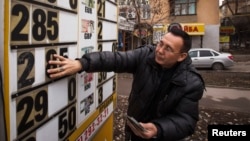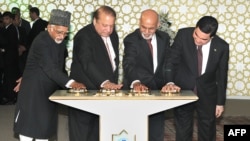
The year 2015 was rough for Central Asia and though it’s unwise to forecast, I’ve got a feeling 2016 is going to be a very eventful year in the region -- and not in a good way.
The year that’s coming to a close saw a drastic economic downturn in Central Asia and an increase in security concerns as the situation in northern Afghanistan deteriorated and the threat of the Islamic State (IS) militant group grew in the minds of Central Asian government officials.
To be fair, many experts in the field of Central Asian studies contend that the security fears are overblown and being used by Central Asia’s governments as a pretext for eliminating perceived domestic opponents.
So was 2015 a temporary setback for Central Asia or the first signs of a longer-term turn for the worse?
RFE/RL’s Turkmen Service, known locally as Azatlyk, assembled the Majlis, a panel, to discuss events in Central Asia in 2015 and what those events might portend.
And for this one, the Majlis brought in people who follow events in Central Asia as closely as anyone in the world.
Azatlyk Director Muhammad Tahir moderated the discussion. Participating from RFE/RL’s Kyrgyz Service, known locally as Azattyk, was Director Venera Djumataeva; from RFE/RL's Tajik Service, known locally as Radio Ozodi, was Ozodi Director Sojida Djakhfarova; and from RFE/RL's Uzbek Service, known locally as Ozodlik, was Senior Correspondent Sirojiddin Tolibov. I also sat in on behalf of RFE/RL's Kazakh Service, known locally as Azattyq.
There were some important elections in Central Asia in 2015, both parliamentary and presidential.
Tajikistan conducted parliamentary elections on March 1 and brought to an end any hint of political pluralism. As Djakhfarova pointed out, after 18 years of a government that included members of genuine opposition parties, the 2015 parliamentary elections “deprived two major opposition parties from seats in the parliament.”
Before the end of 2015, one of those opposition parties -- the Islamic Renaissance Party of Tajikistan -- would have its registration canceled by a court decision and later was declared to be an illegal extremist group.
Kyrgyzstan provided one of the bright moments of 2015 when it conducted its parliamentary elections on October 4. “It was a big political testament in Kyrgyzstan for parliamentary democracy, for the young parliamentary system in Kyrgyzstan, which [is] the only one that exists in Central Asia so far,” Djumataeva said.
Those elections did have some shortcomings and the new deputies have yet to prove they can meet the high expectations the electorate has for them, but the campaigning process was, arguably, the best Central Asia has ever seen.
There were presidential elections also in Kazakhstan and Uzbekistan. Kazakh President Nursultan Nazarbaev and Uzbek President Islam Karimov, the only two leaders in the CIS who have ruled their countries since the first day of independence (and even before that), conducted early elections and received fresh mandates to lead their countries.
There was speculation that the two wanted new terms before the reality of the expected economic crisis in Central Asia really took hold.
Karimov was reelected on March 29 and Nazarbaev on April 26, both officially receiving more than 90 percent of the vote.
Economic Crisis
The economies in their countries, and the other Central Asian states, were already showing signs of severe strain, with several factors combining to the detriment of the region.
There were some states that had grown reliant on remittances from migrant laborers, mainly in Russia. The devaluation of the Russian ruble, caused by falling oil and gas prices on world markets and Western sanctions on Russia for the Kremlin’s role in fighting in eastern Ukraine, impacted millions of Central Asian migrant laborers working in Russia.
Millions of people from Uzbekistan have been sending home money earned in Russia for many years, some $6.6 billion in 2013. Tolibov pointed out “remittances from Russia and abroad decreased by 40 percent,” in 2015 and he added some migrant laborers are returning to Uzbekistan where “the unemployment rate is increasing.”
This has also been a problem in Kyrgyzstan, one of the most remittance-dependent countries in the world.As has been true throughout Central Asia, Kyrgyzstan’s national currency -- the som -- has depreciated in value. Djumataeva noted during 2015 that “Prices jumped up much higher than 30 percent; it is around 50 percent,” which she said led to “half of the construction companies [in Kyrgyzstan] facing bankruptcy.”
And the problem is even more acute in Kyrgyzstan’s agricultural sector.
Kazakhstan’s national currency -- the tenge -- started the year with an exchange rate of some 180 tenge to $1 but as the year drew to a close the rate was some 330 tenge to $1.
In Kazakhstan’s case the cause was more the falling price of oil, the country’s major export, coupled with the economic woes of two of its main trading partners -- Russia and China.
The falling price of natural gas created similar problems in Turkmenistan, where for the first time in many years there were reports of layoffs in the gas sector and even a strike by gas workers in the eastern Lebap Province.
Added to economic troubles were problems south of the Central Asian borders, in Afghanistan. Foreign forces completed their drawdown at the end of 2014 and the previously, relatively peaceful northern provinces saw a large uptick in violence. The provincial capital of Kunduz, not far from Tajikistan, briefly fell into the hands of Taliban and foreign militants in late September. Fighting farther west reached the Turkmen border in several places during the last few months of 2015.
And then there was the specter of the Islamic State (IS) militant group. Hundreds of Central Asians have gone to Syria and Iraq to join the world’s richest terrorist group. Most had been recruited in Russia, where they were working as migrant laborers. But some, including notably the head of Tajikistan’s Interior Ministry commando units, left from Central Asia to join IS.
Russian officials warned Central Asian governments about the growing threat from IS throughout 2015, but these officials were essentially preaching to the choir. The Central Asian governments needed little urging to initiate legislation and measures that simultaneously allowed them to neutralize potential domestic regime opponents, both religious and secular.
The panel discussed these issues in greater detail as well as dealing with other topics.
Listen here for the full audio:








